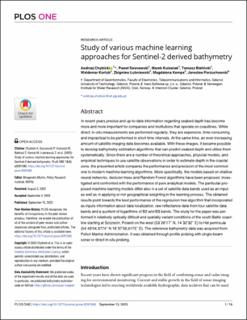| dc.description.abstract | In recent years precise and up-to-date information regarding seabed depth has become more and more important for companies and institutions that operate on coastlines. While direct, in-situ measurements are performed regularly, they are expensive, time-consuming and impractical to be performed in short time intervals. At the same time, an ever-increasing amount of satellite imaging data becomes available. With these images, it became possible to develop bathymetry estimation algorithms that can predict seabed depth and utilize them systematically. Since there are a number of theoretical approaches, physical models, and empirical techniques to use satellite observations in order to estimate depth in the coastal zone, the presented article compares the performance and precision of the most common one to modern machine learning algorithms. More specifically, the models based on shallow neural networks, decision trees and Random Forest algorithms have been proposed, investigated and confronted with the performance of pure analytical models. The particular proposed machine learning models differ also in a set of satellite data bands used as an input as well as in applying or not geographical weighting in the learning process. The obtained results point towards the best performance of the regression tree algorithm that incorporated as inputs information about data localization, raw reflectance data from four satellite data bands and a quotient of logarithms of B2 and B3 bands. The study for the paper was performed in relatively optically difficult and spatially variant conditions of the south Baltic coastline starting at Szczecin, Poland on the west (53°26’17’’ N, 14°32’32’’ E) to Hel peninsula (54°43’04,3774’’ N 18°37’56,9175’’ E). The reference bathymetry data was acquired from Polish Marine Administration. It was obtained through profile probing with single-beam sonar or direct in-situ probing. | en_US |

